TaskUs Bundle
Who Really Owns TaskUs?
Understanding the ownership structure of a company is crucial for investors and business strategists alike. For TaskUs, a leader in outsourced digital services, knowing who controls the company unveils insights into its strategic direction and future potential. This exploration dives deep into the TaskUs SWOT Analysis, examining the evolution of its ownership from its inception to its current standing as a publicly traded entity. This analysis is vital for anyone looking to understand the company's trajectory.
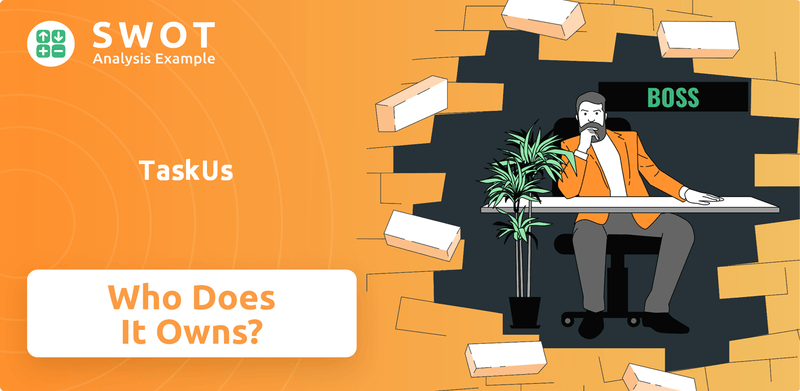
From its humble beginnings in Santa Monica, California, to its current headquarters in New Braunfels, Texas, TaskUs has experienced significant growth. Its impressive 2024 revenue of nearly a billion dollars and a global workforce of approximately 59,000 people highlight the importance of understanding its ownership. This includes identifying the TaskUs owner, the influence of TaskUs executives, and the impact of its public listing on the TaskUs company's future. Knowing the TaskUs ownership details provides a crucial perspective on the company's financial backers and overall legal structure.
Who Founded TaskUs?
The story of the TaskUs company began in 2008 with its co-founders, Bryce Maddock and Jaspar Weir. These high school friends, who had collaborated on other ventures before, laid the groundwork for what would become a significant player in the outsourcing industry. Their initial investment of $25,000 from personal savings marked the beginning of a journey that would see the company grow substantially.
From its inception, TaskUs operated as a limited liability company, a structure that offered flexibility in its early stages. This structure allowed them to distribute phantom stock to employees, which was a strategic move to incentivize and retain talent during the company's early growth phase. This approach helped align employee interests with the company's success.
The first major external funding round came in 2015, when TaskUs secured $15 million in Series A funding from Navegar, a private equity fund based in the Philippines. This investment was particularly significant because Navegar had strong ties to the outsourcing industry in the Philippines, where TaskUs had established a substantial presence. Simultaneously, the company also obtained a $14 million loan from Bridge Bank, providing additional capital to fuel its expansion.
The early financial decisions of TaskUs, including the initial bootstrapping and the subsequent funding rounds, were crucial in shaping its ownership structure and growth trajectory. Here's a breakdown:
- Bootstrapping: The founders initially funded the company with $25,000, demonstrating their early commitment.
- Series A Funding: In 2015, TaskUs raised $15 million from Navegar, a private equity fund.
- Bank Loan: Simultaneously, TaskUs secured a $14 million loan from Bridge Bank.
- Ownership Structure: Early agreements and funding rounds were critical in shaping the nascent ownership structure.
- Expansion: These financial moves enabled the company to scale operations and expand its workforce.
TaskUs SWOT Analysis
- Complete SWOT Breakdown
- Fully Customizable
- Editable in Excel & Word
- Professional Formatting
- Investor-Ready Format
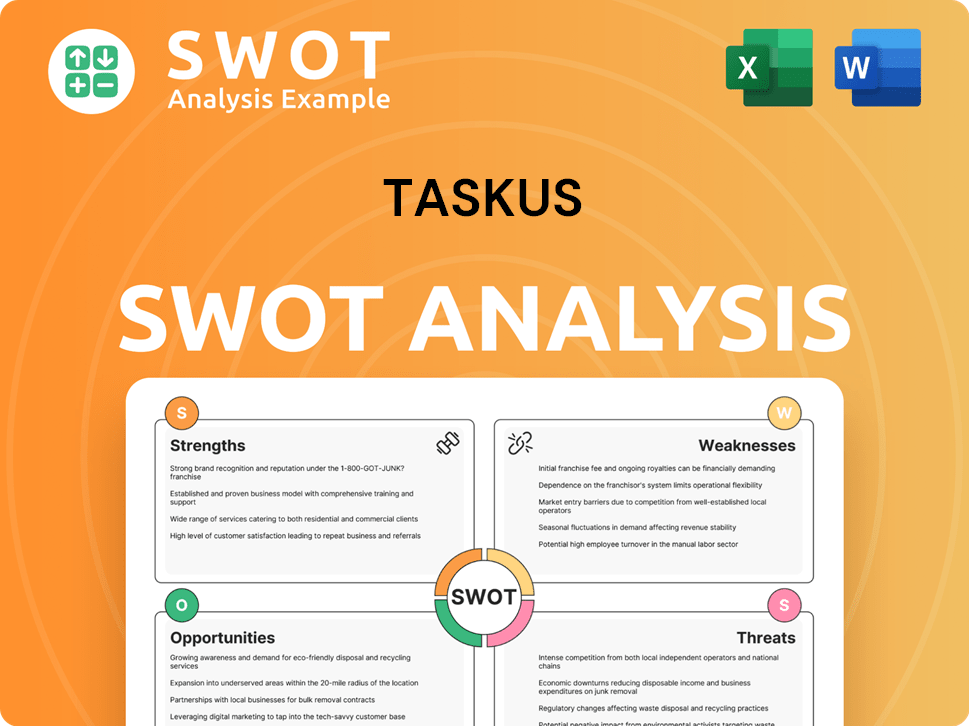
How Has TaskUs’s Ownership Changed Over Time?
The ownership structure of the TaskUs company has seen significant changes over time. A major shift occurred in 2018 when The Blackstone Group Inc. invested $250 million. This investment led to a restructuring, with TaskUs Holdings, Inc. becoming the reporting entity, and a new accounting basis was established.
TaskUs went public on June 11, 2021, through an Initial Public Offering (IPO) on the Nasdaq Global Select Market under the ticker 'TASK.' The IPO involved the sale of 13.2 million shares of Class A common stock at $23.00 per share, raising $303.6 million. The IPO generated gross proceeds of $127.72 million for TaskUs and $221.42 million for selling shareholders. At the time of the IPO, the company's valuation was approximately $2.8 billion, and co-founders Bryce Maddock and Jaspar Weir were estimated to be worth $400 million each.
| Event | Date | Impact |
|---|---|---|
| Blackstone Group Investment | 2018 | Restructuring and new accounting basis. |
| Initial Public Offering (IPO) | June 11, 2021 | Raised $303.6 million, company valued at ~$2.8 billion. |
| Ongoing Ownership | As of April 2025 | Majority of voting power retained by founders and Blackstone. |
Following the IPO, Bryce Maddock, Jaspar Weir, and affiliates of The Blackstone Group Inc. retained all issued and outstanding Class B common stock, maintaining a majority of the voting power. This structure meant TaskUs remained a 'controlled company' under Nasdaq's corporate governance rules. As of April 2025, the ownership breakdown shows that Venture Capital/Private Equity (VC/PE) firms hold about 53% of the ownership, while institutional investors hold 18.3%. Individual insiders hold 28.5%, and the general public holds 0.174%. Key institutional shareholders include Blackstone Inc., The Vanguard Group, Inc., and BlackRock, Inc. TaskUs's revenue in 2024 was $994.99 million.
The ownership of TaskUs has evolved significantly, from private equity backing to a public listing. The IPO in 2021 marked a pivotal moment, and the company continues to be largely controlled by insiders and major institutional investors. Understanding the TaskUs ownership structure is crucial for investors and stakeholders alike.
- The Blackstone Group's 2018 investment was a key event.
- The IPO in 2021 brought in significant capital.
- VC/PE firms remain the largest owners.
- The founders and Blackstone retain significant influence.
TaskUs PESTLE Analysis
- Covers All 6 PESTLE Categories
- No Research Needed – Save Hours of Work
- Built by Experts, Trusted by Consultants
- Instant Download, Ready to Use
- 100% Editable, Fully Customizable
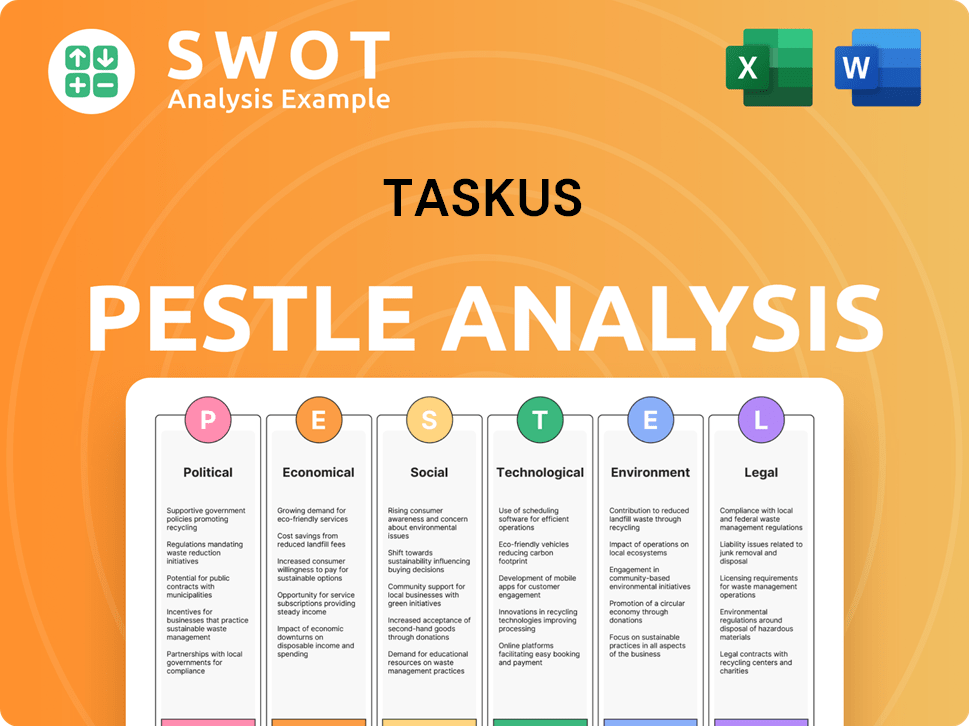
Who Sits on TaskUs’s Board?
The Board of Directors of the [Company Name] is pivotal in its governance, with representation from key shareholders and founders. The co-founders, Bryce Maddock and Jaspar Weir, are both members of the board. As of May 2025, the Class I directors included Bryce Maddock, Jacqueline Reses, and Kelly Tuminelli, whose terms were ending, with re-election for new three-year terms expiring in 2028. Class II directors, Amit Dixit, Michelle Gonzalez, and Jaspar Weir, currently have terms expiring at the 2026 Annual Meeting. Understanding the TaskUs ownership structure is crucial for grasping the company's operational dynamics.
The composition of the board reflects the influence of major stakeholders. The board's structure and the distribution of voting power are critical elements in understanding how decisions are made within the company. This is particularly important when considering the long-term strategy and direction of the company. Knowing TaskUs executives and their roles is also essential.
| Director | Class | Term Expires |
|---|---|---|
| Bryce Maddock | I | 2028 |
| Jacqueline Reses | I | 2028 |
| Kelly Tuminelli | I | 2028 |
| Amit Dixit | II | 2026 |
| Michelle Gonzalez | II | 2026 |
| Jaspar Weir | II | 2026 |
The company operates with a dual-class share structure, which significantly impacts voting dynamics. Each share of Class A common stock has one vote, while each share of Class B common stock has ten votes. Class B stock can convert to Class A at any time. This structure ensures that the co-founders and Blackstone, who hold all Class B shares, maintain majority voting power. As of April 1, 2022, Blackstone Inc. and the co-founders held approximately 96.3% of the combined voting power of Class A and Class B common stock. This concentration allows controlling shareholders to approve actions that might not be supported by public shareholders. The TaskUs owner structure, with its dual-class shares, can affect the company's eligibility for certain indices. For more insights, explore the Target Market of TaskUs.
The dual-class share structure gives significant voting power to co-founders and Blackstone. This structure allows controlling shareholders to influence major decisions. Understanding the voting power distribution is key to assessing corporate governance.
- Dual-class structure impacts voting dynamics.
- Class B shares hold ten votes each.
- Blackstone and co-founders control majority voting power.
- This can affect the company's inclusion in indices.
TaskUs Business Model Canvas
- Complete 9-Block Business Model Canvas
- Effortlessly Communicate Your Business Strategy
- Investor-Ready BMC Format
- 100% Editable and Customizable
- Clear and Structured Layout
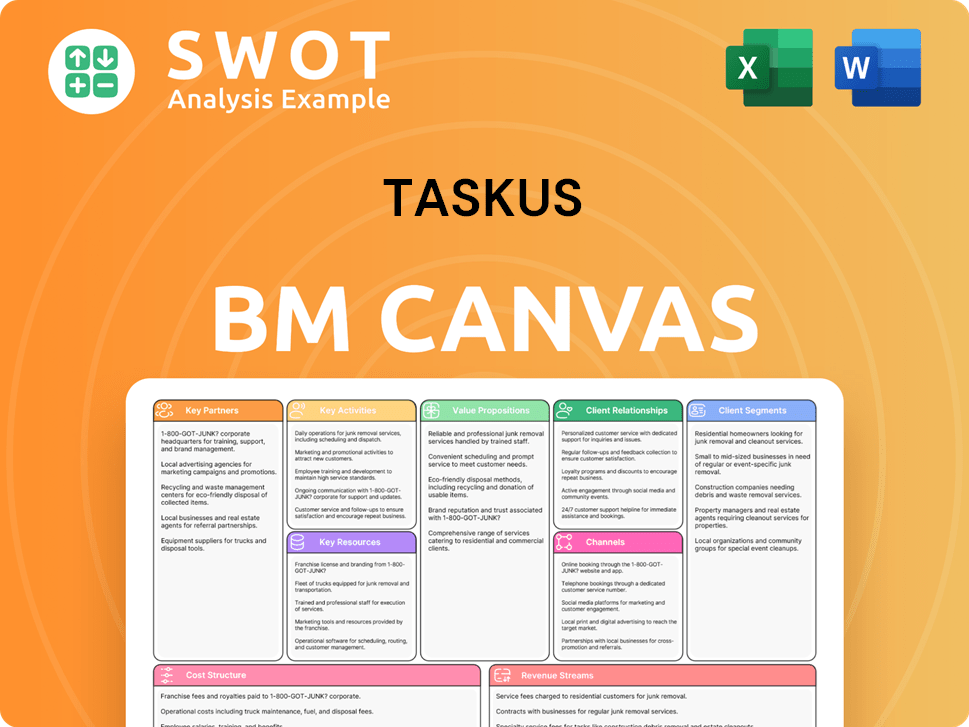
What Recent Changes Have Shaped TaskUs’s Ownership Landscape?
In recent years, the ownership of the TaskUs company has undergone significant changes. A major development occurred in May 2025 when an agreement was reached for the company to be acquired by an affiliate of Blackstone, along with co-founders Bryce Maddock and Jaspar Weir, forming the 'Buyer Group'. This move to privatize the company, with the TaskUs executives taking part, has raised questions about potential conflicts of interest.
The proposed acquisition involves a cash offer of $16.50 per share, which represents a premium over the company's recent trading price. However, some shareholder rights firms have launched investigations, claiming the offer undervalues the company, especially when compared to analyst targets. This situation highlights the complexities of the TaskUs ownership structure and the ongoing dynamics within the company.
| Metric | Value | Date |
|---|---|---|
| Total Revenue | $995 million | December 31, 2024 |
| Adjusted EBITDA | $209.9 million | December 31, 2024 |
| Projected Revenue | $1.095 billion - $1.125 billion | 2025 |
| Institutional Ownership (Class A) | Approximately 18.15% | April 2025 |
| Individual Insider Ownership | 28.5% | April 2025 |
| Workforce | Approximately 59,000 teammates | End of 2024 |
As of April 2025, institutional investors held about 18.15% of the Class A common stock of TaskUs, with mutual funds slightly reducing their holdings. Individual insiders, including the TaskUs owner, held a significant 28.5% of the shares. The company's financial performance, with revenues nearing $1 billion by the end of 2024, and an expanding workforce, underscore its growth trajectory. For more information about the competitive landscape, consider reading about the Competitors Landscape of TaskUs.
The proposed acquisition by Blackstone and the co-founders marks a key shift in the TaskUs ownership structure, potentially impacting the company's future direction. This change is a notable development in the company’s history.
Shareholder rights firms have raised concerns about the acquisition, citing potential undervaluation and conflicts of interest. These concerns highlight the importance of fair valuation in such transactions and the need for transparent governance.
The company's strong financial results, with nearly $1 billion in revenue by the end of 2024 and a projected increase for 2025, reflect its growth and market position. This growth is key to understanding its value.
The distribution of shares among institutional investors and insiders provides insights into the company’s ownership dynamics. The changes in ownership structure are important to watch.
TaskUs Porter's Five Forces Analysis
- Covers All 5 Competitive Forces in Detail
- Structured for Consultants, Students, and Founders
- 100% Editable in Microsoft Word & Excel
- Instant Digital Download – Use Immediately
- Compatible with Mac & PC – Fully Unlocked
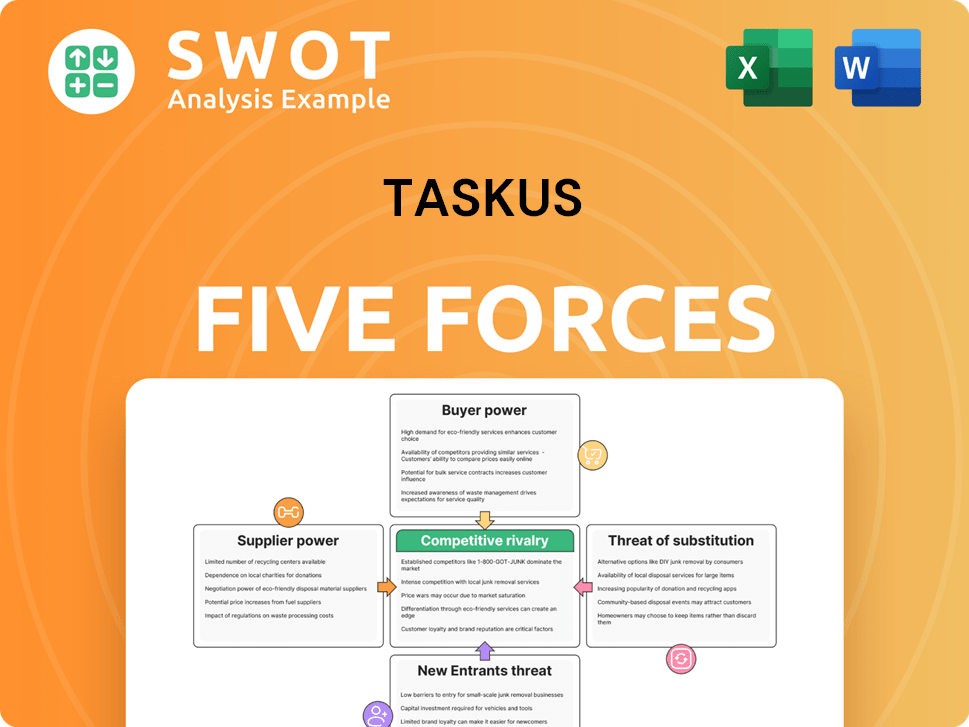
Related Blogs
- What are Mission Vision & Core Values of TaskUs Company?
- What is Competitive Landscape of TaskUs Company?
- What is Growth Strategy and Future Prospects of TaskUs Company?
- How Does TaskUs Company Work?
- What is Sales and Marketing Strategy of TaskUs Company?
- What is Brief History of TaskUs Company?
- What is Customer Demographics and Target Market of TaskUs Company?
Disclaimer
All information, articles, and product details provided on this website are for general informational and educational purposes only. We do not claim any ownership over, nor do we intend to infringe upon, any trademarks, copyrights, logos, brand names, or other intellectual property mentioned or depicted on this site. Such intellectual property remains the property of its respective owners, and any references here are made solely for identification or informational purposes, without implying any affiliation, endorsement, or partnership.
We make no representations or warranties, express or implied, regarding the accuracy, completeness, or suitability of any content or products presented. Nothing on this website should be construed as legal, tax, investment, financial, medical, or other professional advice. In addition, no part of this site—including articles or product references—constitutes a solicitation, recommendation, endorsement, advertisement, or offer to buy or sell any securities, franchises, or other financial instruments, particularly in jurisdictions where such activity would be unlawful.
All content is of a general nature and may not address the specific circumstances of any individual or entity. It is not a substitute for professional advice or services. Any actions you take based on the information provided here are strictly at your own risk. You accept full responsibility for any decisions or outcomes arising from your use of this website and agree to release us from any liability in connection with your use of, or reliance upon, the content or products found herein.